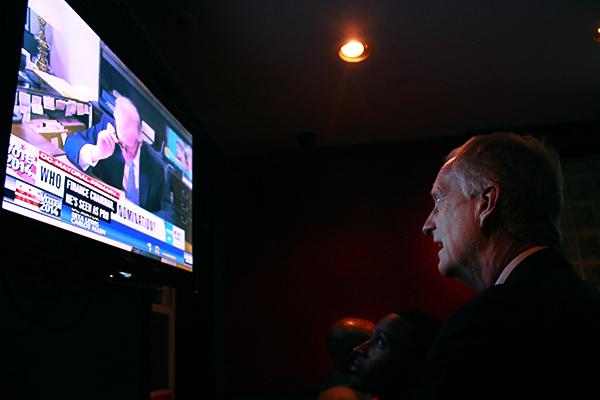Though he finished with only 5 percent of the vote in last week’s Democratic mayoral primary, two-decade Council member Jack Evans says he did everything right in the race.
By nearly all accounts, Evans’ campaign ran like a well-oiled machine from his 14th Street office, leading the field in fundraising after raking in more than $1.4 million in contributions, attracting big crowds at D.C. landmarks like Ben’s Chili Bowl and covering hundreds of lampposts with signs throughout the city.
“We started off by raising the most money, gathering the most signatures, having a great office, the most volunteers and signs everywhere,” Evans said Thursday. “I have no regrets about what we could have done better.”
But after his distant fourth-place finish, far behind winner Council member Muriel Bowser, many have pointed to Evans’ failure to connect with and relate to voters.
Even though Evans pushed his two-decade-long economic record on the D.C. Council and attracted support from businesses, Evans couldn’t overcome his close ties with embattled incumbent Mayor Vincent Gray, said Corey Goldstone, who helped steer Evans’ campaign communication.
Evans, who has been friends with Gray for years, struggled to separate himself once the mayor jumped in the race in January. He decided not to take a hard-line approach against the accusations of corruption, which Goldstone said hurt the campaign’s chances with voters who wanted Gray out of office.

“Running an anti-Gray campaign was not in the DNA of an Evans campaign. Jack was just never very comfortable criticizing the mayor,” Goldstone said.
Mark Plotkin, an alumnus and correspondent at BBC News, said Evans’ failure to connect with voters in his own ward revealed his message’s weaknesses.
“I think the thing that disturbed him was that his own ward didn’t even vote for him. It hurts when your own people don’t do that,” Plotkin said. Evans pulled in about 18 percent of the vote in Ward 2.
Goldstone said Evans – and most of his campaign staff – were caught off guard when Gray announced he would run for reelection this winter because of what they believed was an imminent indictment. He said they believed the chance of Gray running again was less than 25 percent.
Then as Gray pulled in fundraising totals to rival Evans, and Council member Muriel Bowser nabbed the Washington Post’s endorsement, the race shaped up to a duel between Bowser and Gray.
Bowser, a Ward 4 Council member whose family has long been active in D.C. politics, earned the surprise victory in last week’s election with 44 percent of the vote.
She also pulled in about 50 percent of the vote in Ward 2, an area that includes GW, where Gray had been a student in the 1960s. Evans said the loss in support was because locals doubted he could beat an incumbent.
Willem Brakel, 64, said though he lives in Evans’ ward, he voted for Bowser because he thought she was the candidate who could move the city forward and away from the corruption that marred the Gray administration.
“I have considerable respect for Jack, but I think he is part of an older generation,” Brakel said. “I think a white mayor in his 60s from Georgetown doesn’t capture the imaginations of this whole city. He doesn’t understand and he doesn’t have the energy that Muriel Bowser has. She is young – she is part of a new generation.”
Evans’ popularity was also tempered by his ties to big business in a city concerned with issues like affordable housing and being priced out of their neighborhoods, he said.
“He’s a candidate who has made his name developing the downtown area and dramatically improving the quality of life in his ward, but people in other wards saw Jack and said, ‘Does he understand my life or my problems?’” Goldstone said. “Affordability, gentrification, any time these words were mentioned, it was a negative for Jack and a positive for other candidates who showed it was their chief concern.”
More than half of D.C. residents believe the city’s booming development benefits whites and wealthy individuals more than blacks and low-income residents, leaving the city divided along racial and socioeconomic lines, according to a January poll in the Washington Post.
Plotkin said Ward 2, which includes GW and Georgetown University, could have been an Evans stronghold if he’d managed to get votes from college students, a demographic that rarely votes in city elections.
Tom Lindenfeld, the top strategist for Bowser’s campaign who also worked for former mayor Adrian Fenty, said the results of the election show that the city wanted a fresh start with a relatable mayor.
“The bottom line is, Muriel was the only candidate who ran throughout the entire city. No other candidate appealed to voters and tried to appeal to voters in areas that were black and white, rich and poor, and at the end of the day that worked,” Lindenfeld said.
Bowser now has eight months until the general election, in which she will face David Catania, an independent, at-large Council member who is the chair of the education committee. She has promised to improve middle schools by replicating successful programs in certain parts of the city, appoint a “deputy mayor East of the River” and create incentives for first-time homebuyers.
Rachael Gerendasy contributed reporting.







